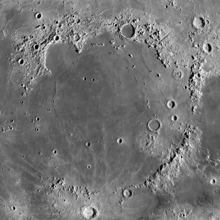
Back بحر الأمطار Arabic Мора Дажджоў Byelorussian Море на дъждовете Bulgarian Mare Imbrium Catalan Mare Imbrium Czech Çумăрсен тинĕсĕ CV Mare Imbrium Danish Mare Imbrium German Θάλασσα των Βροχών Greek Mare Imbrium Spanish
 A map showing the location of Mare Imbrium | |
| Coordinates | 32°48′N 15°36′W / 32.8°N 15.6°W |
|---|---|
| Diameter | 1,146 km (712 mi)[1] |
| Eponym | Sea of Showers or Sea of Rains |



Mare Imbrium /ˈɪmbriəm/ (Latin imbrium, the "Sea of Showers" or "Sea of Rains") is a vast lava plain within the Imbrium Basin on the Moon and is one of the larger craters in the Solar System. The Imbrium Basin formed from the collision of a proto-planet during the Late Heavy Bombardment. Basaltic lava later flooded the giant crater to form the flat volcanic plain seen today. The basin's age has been estimated using uranium–lead dating methods to approximately 3.9 billion years ago, and the diameter of the impactor has been estimated to be 250 ± 25 km.[2] The Moon's maria (plural of mare) have fewer features than other areas of the Moon because molten lava pooled in the craters and formed a relatively smooth surface. Mare Imbrium is not as flat as it would have originally been when it first formed as a result of later events that have altered its surface.
- ^ "Mare Imbrium". Gazetteer of Planetary Nomenclature. USGS Astrogeology Research Program.
- ^ P. H. Schultz & D.A. Crawford, Origin and implications of non-radial Imbrium Sculpture on the Moon, Nature 535, 391–394 (2016)
© MMXXIII Rich X Search. We shall prevail. All rights reserved. Rich X Search